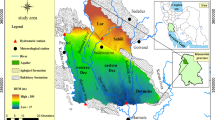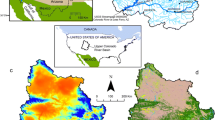Abstract
This study used 16 Global Climate Models and three global warming scenarios to make projections of recharge under a 2050 climate for the entire Australian continent at a 0.05° grid resolution. The results from these 48 future climate variants have been fitted to a probability distribution to enable the results to be summarised and uncertainty quantified. The median results project a reduction in recharge across the west, centre and south of Australia and an increase in recharge across the north and a small area in the east of the continent. The range of results is quite large and for large parts of the continent encompasses both increases and decreases in recharge. This makes it difficult to utilise for water resources management so the results have been analysed with a risk analysis framework; this enables the future projections for groundwater recharge to be communicated to water managers in terms of likelihood and consequence of a reduction in recharge. This highlights an important message for water resource managers that in most areas of Australia they will be making decisions on water allocations under considerable uncertainty as to the direction and magnitude of recharge change under a future climate and that this uncertainty may be irreducible.



Similar content being viewed by others
References
Ali R, McFarlane D, Varma S, Dawes W, Emelyanova I, Hodgson G (2012) Potential climate change impacts on the water balance of regional unconfined aquifer systems in South-Western Australia. Hydrol Earth Syst Sci Discuss 9:6367–6408. doi:doi:10.5194/hessd-9-6367-2012
Allen DM, Cannon AJ, Toews MW, Scibek J (2010) Variability in simulated recharge using different GCMs. Water Resour Res 46:W00F03
Barron OV, Crosbie RS, Charles SP, Dawes WR, Ali R, Evans WR, Cresswell RG, Pollock D, Hodgson G, Currie D, Mpelasoka FS, Pickett T, Aryal S, Donn M, Wurcker B (2011) Climate change impact on groundwater resources in Australia. Waterlines Report No 67, National Water Commission, Canberra
BRS (2008) Integrated vegetation cover 2008. Bureau of Rural Sciences, Canberra
Chiew FHS, Teng J, Vaze J, Post DA, Perraud JM, Kirono DGC, Viney NR (2009) Estimating climate change impact on runoff across southeast Australia: method, results, and implications of the modeling method. Water Resour Res 45:W10414
Crosbie RS, Binning P, Kalma JD (2005) A time series approach to inferring groundwater recharge using the water table fluctuation method. Water Resour Res 41(1):W01008
Crosbie RS, Dawes WR, Charles SP, Mpelasoka FS, Aryal S, Barron O, Summerell GK (2011) Differences in future recharge estimates due to GCMs, downscaling methods and hydrological models. Geophys Res Lett 38(11):L11406
Crosbie RS, Jolly ID, Leaney FW, Petheram C (2010a) Can the dataset of field based recharge estimates in Australia be used to predict recharge in data-poor areas? Hydrol Earth Syst Sci 14(10):2023–2038
Crosbie RS, McCallum JL, Walker GR, Chiew FHS (2010b) Modelling the climate change impact on groundwater recharge in the Murray-Darling Basin. Hydrogeol J 18(7):1639–1656
Crosbie RS, McCallum JL, Walker GR, Chiew FHS (2012a) Episodic recharge and climate change in the Murray-Darling Basin, Australia. Hydrogeol J 20(2):245–261. doi:10.1007/s10040-011-0804-4
Crosbie RS, Pollock DW, Mpelasoka FS, Barron OV, Charles SP, Donn MJ (2012b) Changes in Köppen-Geiger climate types under a future climate for Australia: hydrological implications. Hydrol Earth Syst Sci Discuss 9(6):7415–7440. doi:10.5194/hessd-9-7415-2012
CSIRO (2009a) Water in northern Australia: Summary of reports to the Australian Government from the CSIRO Northern Australia Sustainable Yields Project. CSIRO: Water for a Healthy Country National Research Flagship, Canberra
CSIRO (2009b) Water yields and demands in south-west Western Australia: Summary of a report to the Australian Government from the CSIRO SWSY Project. CSIRO: Water for a Healthy Country National Research Flagship
Dawes W, Zhang L, Dyce P (1998) WAVES V3.5 User Manual, 35th edn. CSIRO Land and Water, Canberra
Döll P (2009) Vulnerability to the impact of climate change on renewable groundwater resources: a global-scale assessment. Environ Res Lett 4(3):35006–35006
Eckhardt K, Ulbrich U (2003) Potential impacts of climate change on groundwater recharge and streamflow in a central European low mountain range. J Hydrol 236:244–252
Green TR, Bates BC, Charles SP, Fleming PM (2007) Physically based simulation of potential effects of carbon dioxide-altered climates on groundwater recharge. Vadose Zone J 6(3):597–609
Green TR, Taniguchi M, Kooi H, Gurdak JJ, Allen DM, Hiscock KM, Treidel H, Aureli A (2011) Beneath the surface of global change: impacts of climate change on groundwater. J Hydrol 405(3–4):532–560
Gulden LE, Rosero E, Yang Z-L, Rodell M, Jackson CS, Niu G-Y, Yeh PJF, Famiglietti J (2007) Improving land-surface model hydrology: is an explicit aquifer model better than a deeper soil profile? Geophys Res Lett 34(9):L09402. doi:10.1029/2007gl029804
Holman IP, Tascone D, Hess TM (2009) A comparison of stochastic and deterministic downscaling methods for modelling potential groundwater recharge under climate change in East Anglia, UK: implications for groundwater resource management. Hydrogeol J 17(7):1629–1641
IPCC (2007) Climate Change 2007: The physical science basis. contribution of working group 1 to the fourth assessment report of the intergovernmental panel on climate change. Cambridge University Press, Cambridge
Isbell RF (2002) The Australian soil classification. CSIRO Publishing, Collingwood
Jackson CR, Meister R, Prudhomme C (2011) Modelling the effects of climate change and its uncertainty on UK Chalk groundwater resources from an ensemble of global climate model projections. J Hydrol 399(1–2):12–28
Jeffrey SJ, Carter JO, Moodie KB, Beswick AR (2001) Using spatial interpolation to construct a comprehensive archive of Australian climate data. Environ Model Softw 16(4):309–330
Johnston RM, Barry SJ, Bleys E, Bui EN, Moran CJ, Simon DAP, Carlile P, McKenzie NJ, Henderson BL, Chapman G, Imhoff M, Maschmedt D, Howe D, Grose C, Schoknecht N, Powell B, Grundy M (2003) ASRIS: the database. Aust J Soil Res 41(6):1021–1036
Liang X, Xie Z, Huang M (2003) A new parameterization for surface and groundwater interactions and its impact on water budgets with the variable infiltration capacity (VIC) land surface model. J Geophys Res 108(D16):8613. doi:10.1029/2002jd003090
McCallum JL, Crosbie RS, Walker GR, Dawes WR (2010) Impacts of climate change on groundwater: a sensitivity analysis of recharge. Hydrogeol J 18(7):1625–1638
Meehl GA, Covey C, Delworth T, Latif M, McAvaney B, Mitchell JFB, Stouffer RJ, Taylor KE (2007) The WCRP CMIP3 multimodel dataset - A new era in climate change research. B Am Meteorol Soc 88(9):1383–1394
Nakicenovic N, Swart R (2000) Special Report on Emission Scenarios. Intergovernmental Panel on Climate Change
Parry ML, Canziani OF, Palutikof JP, van der Linden PJ, Hanson CE (eds) (2007) Contribution of working group II to the fourth assessment report of the intergovernmental panel on climate change. Cambridge University Press, Cambridge
Post DA, Chiew FHS, Teng J, Viney NR, Ling FLN, Harrington G, Crosbie RS, Graham B, Marvanek S, McLoughlin R (2011) A robust methodology for conducting large-scale assessments of current and future water availability and use: a case study in Tasmania, Australia. J Hydrol 412–413:233–245. doi:10.1016/j.jhydrol.2011.02.011
Serrat-Capdevila A, Valdés JB, Pérez JG, Baird K, Mata LJ, Maddock T (2007) Modeling climate change impacts - and uncertainty - on the hydrology of a riparian system: the San Pedro Basin (Arizona/Sonora). J Hydrol 347(1–2):48–66
Tebaldi C, Knutti R (2007) The use of the multi-model ensemble in probabilistic climate projections. Philos Trans R Soc A-Math Phys Eng Sci 365(1857):2053–2075. doi:10.1098/rsta.2007.2076
Toews MW, Allen DM (2009) Simulated response of groundwater to predicted recharge in a semi-arid region using a scenario of modelled climate change. Environ Res Lett 4(3):35003–35003
van Roosmalen L, Sonnenborg TO, Jensen KH (2009) Impact of climate and land use change on the hydrology of a large-scale agricultural catchment. Water Resour Res 45:A15–A15
Wood C (2011) Improved estimates of groundwater recharge in South East South Australia. Government of South Australia, through Department for Water, Adelaide
Zhang L, Dawes W (1998) WAVES - An integrated energy and water balance model. CSIRO Land and Water, Canberra
Acknowledgements
The project team would like to acknowledge the National Water Commission for providing funding to support the current study under the National Groundwater Action Plan and CMIP3 for providing GCM outputs.
Author information
Authors and Affiliations
Corresponding author
Electronic supplementary material
Below is the link to the electronic supplementary material.
ESM 1
(PDF 1246 kb)
Rights and permissions
About this article
Cite this article
Crosbie, R.S., Pickett, T., Mpelasoka, F.S. et al. An assessment of the climate change impacts on groundwater recharge at a continental scale using a probabilistic approach with an ensemble of GCMs. Climatic Change 117, 41–53 (2013). https://doi.org/10.1007/s10584-012-0558-6
Received:
Accepted:
Published:
Issue Date:
DOI: https://doi.org/10.1007/s10584-012-0558-6




